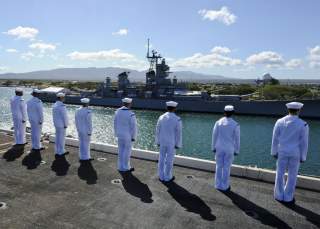Why the Navy Doesn’t Need New Battleships
We have our generation’s battleships in nuclear aircraft carriers. They are majestic, imposing, ocean-going and potentially fading into obsolescence as missiles threaten to outrange and outpunch their organic fighter complement. The future is not bigger ships with more armor.
Worth considering is the fact that the U.S. Navy’s current woes stem more from a lack of ships in enough numbers and sailors to crew them than the lack of any specific platform. Operations all over the world have severely degraded the effectiveness of the force, with too many missions and not enough ships to go around. When the John S. McCain and Fitzgerald both experienced fatal collisions in the Pacific Theater, fatigued and inadequately trained crews were highlighted as some of the causes for the accident. Consolidating construction dollars and manpower in fewer, larger hulls would exacerbate this problem. Additionally, introducing new capital ships into the fleet would drain resources even more by their very presence. Carriers sortie in consort with at least five escort and support ships of various types. Ships escorting a modern battleships are destroyers and submarines which cannot operate independently in regular freedom of navigation exercises, on patrols, or in support of Special Operations and counterterrorism forces.
Beyond the lost opportunity cost of an array of escort vessels and the strain on a Navy already short of manpower, the financial cost would be considerable. To mount the kind of armor, powerplant, and array of weapons that would justify the creation of a floating arsenal would constitute an effort akin to building a nuclear aircraft carrier. Robert Farley wrote in Foxtrot Alpha that the anticipated cost of a modernized battleship example would be $4-10 billion, not less than the Zumwalt-class stealth destroyers and probably more in the neighborhood of the Ford-class supercarriers. Without an existing Gun Club in the Navy, it’s inconceivable planners would countenance the cancellation of planned carriers or ballistic missile submarines to accommodate new dreadnoughts; any purchases would therefore be in addition to existing expensive ships.
Conclusion
We have our generation’s battleships in nuclear aircraft carriers. They are majestic, imposing, ocean-going and potentially fading into obsolescence as missiles threaten to outrange and outpunch their organic fighter complement. The future is not bigger ships with more armor. Not only does history bear out the folly of putting most of one’s resources and striking power into singular ships vulnerable to the prevailing weapons of the day, it also bears out the reality that armor has never been a sufficient or enduring advantage in warfare. Russian battleships at Tsushima were well-armored, but fell victim to superior Japanese seamanship and gunnery, and to the innovation of modern torpedoes in fleet action. Even if armor ensures the ships remain afloat, simply existing is not a sufficient condition for a warship to be useful. Even the most advanced ships are ultimately merely conveyance for weapons and their human operators, and no amount of armor would be sufficient to ensure the survivability of the delicate weapons and supporting systems necessary for modern warfare.
As one naval officer argued in 2017, the naval paradigm has shifted for the foreseeable future away from big and heavy-hitting and toward small, stealthy, and multi-capable ships. Further experimentation in drones and swarm technology will cement this paradigm, as large ships with large crews become even more inviting and vulnerable targets for technologically adept nations of the world. In the meantime, U.S. guided missile submarines and destroyers, bolstered by the new future frigate will continue to prove adept at their responsibility for the capabilities once assigned to battleships. Concerns about A2/AD environments in U.S. operations are valid, but are better addressed via more capable weapons rather than a renaissance for heavily armored behemoths.
Justin Mohn is a writer based in Kansas City whose work has appeared in The Center for Insurance Policy and Research. Justin previously worked in NATO’s Defence Investment Division, and received his master’s in security studies in 2017 from Kansas State University.

